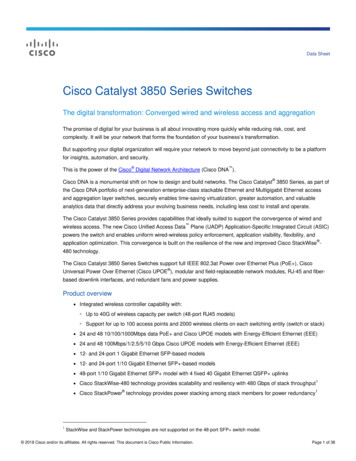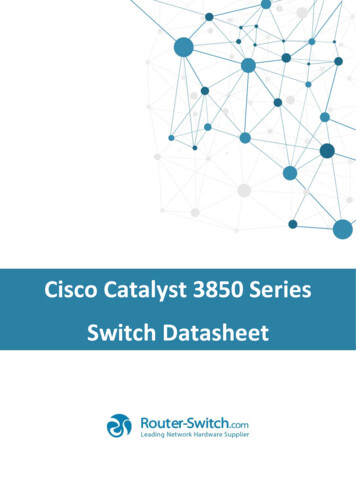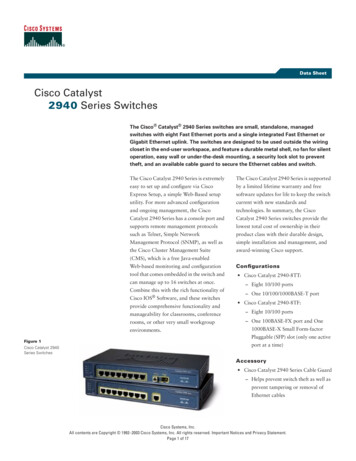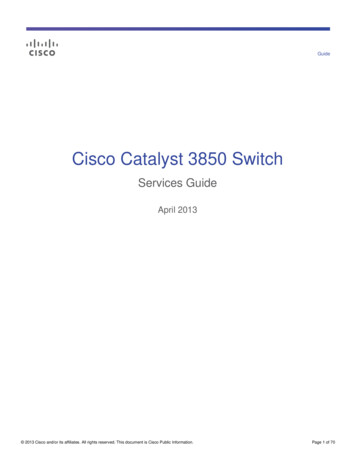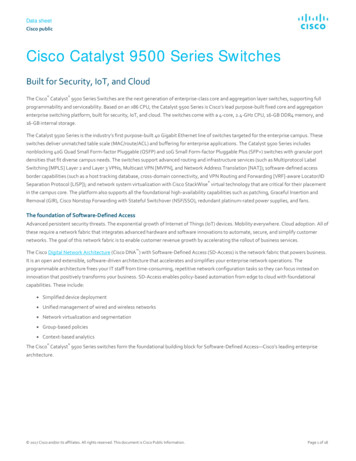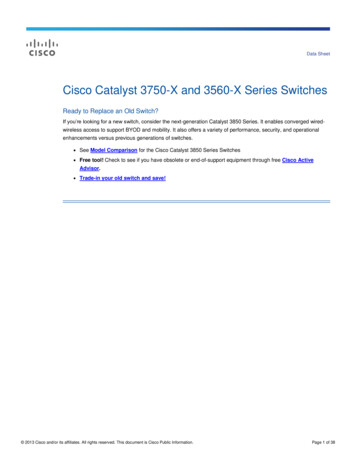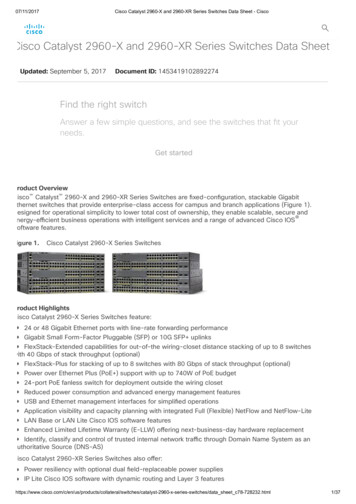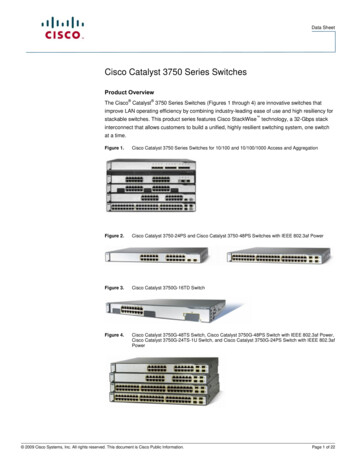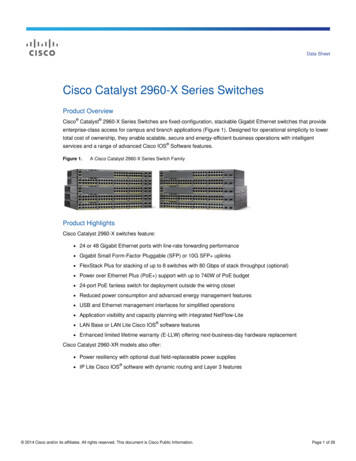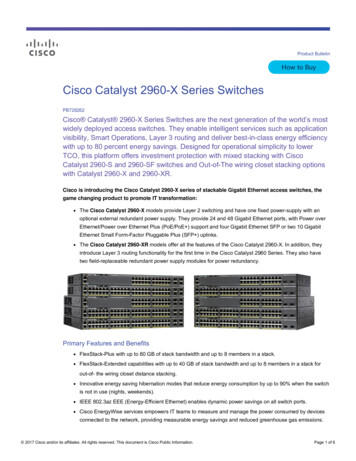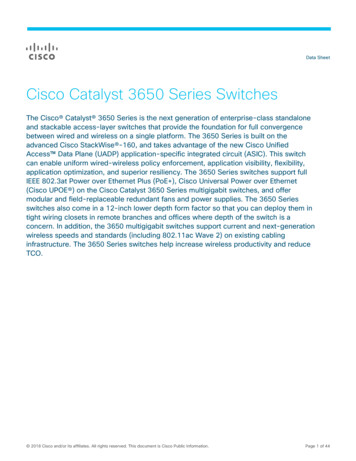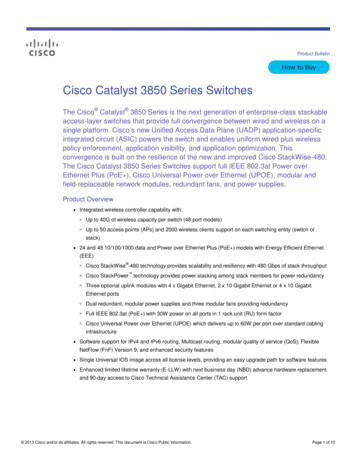
Transcription
Product BulletinHow to BuyCisco Catalyst 3850 Series SwitchesThe Cisco Catalyst 3850 Series is the next generation of enterprise-class stackableaccess-layer switches that provide full convergence between wired and wireless on asingle platform. Cisco’s new Unified Access Data Plane (UADP) application-specificintegrated circuit (ASIC) powers the switch and enables uniform wired plus wirelesspolicy enforcement, application visibility, and application optimization. Thisconvergence is built on the resilience of the new and improved Cisco StackWise-480.The Cisco Catalyst 3850 Series Switches support full IEEE 802.3at Power overEthernet Plus (PoE ), Cisco Universal Power over Ethernet (UPOE), modular andfield-replaceable network modules, redundant fans, and power supplies.Product Overview Integrated wireless controller capability with: Up to 40G of wireless capacity per switch (48 port models) Up to 50 access points (APs) and 2000 wireless clients support on each switching entity (switch orstack) 24 and 48 10/100/1000 data and Power over Ethernet Plus (PoE ) models with Energy Efficient Ethernet(EEE) Cisco StackWise -480 technology provides scalability and resiliency with 480 Gbps of stack throughput Cisco StackPower technology provides power stacking among stack members for power redundancy Three optional uplink modules with 4 x Gigabit Ethernet, 2 x 10 Gigabit Ethernet or 4 x 10 Gigabit Ethernet ports Dual redundant, modular power supplies and three modular fans providing redundancy Full IEEE 802.3at (PoE ) with 30W power on all ports in 1 rack unit (RU) form factor Cisco Universal Power over Ethernet (UPOE) which delivers up to 60W per port over standard cablinginfrastructure Software support for IPv4 and IPv6 routing, Multicast routing, modular quality of service (QoS), FlexibleNetFlow (FnF) Version 9, and enhanced security features Single Universal IOS image across all license levels, providing an easy upgrade path for software features Enhanced limited lifetime warranty (E-LLW) with next business day (NBD) advance hardware replacementand 90-day access to Cisco Technical Assistance Center (TAC) support 2013 Cisco and/or its affiliates. All rights reserved. This document is Cisco Public Information.Page 1 of 10
BenefitsConverged Wired plus Wireless AccessThe Cisco Catalyst 3850 is the first stackable access switching platform that enables wired plus wireless serviceson a single Cisco IOS XE Software-based platform. With this, Cisco has pioneered a host of rich capabilities suchas high availability based on stateful switchover (SSO) on stacking, granular QoS, security, and Flexible Netflow(FNF) across wired and wireless in a seamless fashion. Also, the wired plus wireless features are bundled into asingle Cisco IOS Software image, which reduces the number of software images that users have to qualify/certifybefore enabling them in their network. The single console port for command-line interface (CLI) managementreduces the number of touch points to manage for wired plus wireless services, thereby reducing networkcomplexity, simplifying network operations, and lowering the TCO to manage the infrastructure.Converged wired plus wireless not only improves wireless bandwidth across the network but also the scale ofwireless deployment. Each 48-port Cisco Catalyst 3850 provides 40 Gbps of wireless throughput (20 Gbps on the24-port model). This wireless capacity increases with the number of members in the stack. This makes sure thatthe network can scale with current wireless bandwidth requirements, as dictated by IEEE 802.11n-based accesspoints and with future wireless standards such as IEEE 802.11ac. Additionally, the Cisco Catalyst 3850 distributesthe wireless controller functions to achieve better scalability. Each Cisco Catalyst 3850 switch/stack can operateas the wireless controller in two modes: Mobility agent (MA): This is the default mode in which the Cisco Catalyst 3850 switch ships. In this modethe switch is capable of terminating the CAPWAP tunnels from the access points and providing wirelessconnectivity to wireless clients. Maintaining wireless client databases and configuring and enforcingsecurity and QoS policies for wireless clients and access points can be enforced in this mode. Noadditional license on top of IP Base is required to operate in the mobility agent mode. Mobility controller (MC): In this mode, the Cisco Catalyst 3850 switch can perform all the mobility agenttasks in addition to mobility coordination, radio resource management (RRM), and Cisco CleanAir coordination within a mobility subdomain. The mobility controller mode can be enabled on the switch CLI.IP Base license level is required when the Cisco Catalyst 3850 switch is acting as the mobility controller.A centrally located Cisco 5508 Wireless LAN Controller (WLC 5508), Cisco Wireless Services Module 2(WiSM2) (when running AireOS Version 7.3), and Wireless LAN Controller 5760 can also perform this rolefor larger deployments.With mobility agents located in the wiring closets providing 40 Gbps of wireless per switch (n x 40 Gbps for astack of n switches) and mobility controllers managing some of the central wireless functions, the convergedaccess-based wireless deployment provides best-in-class scalability for wireless and significantly improvedwireless throughput. 2013 Cisco and/or its affiliates. All rights reserved. This document is Cisco Public Information.Page 2 of 10
Figure 1.Mobility Controller (MC) and Mobility Agent (MA)Distributed Intelligent ServicesFlexible NetFlow (FNF)Full visibility into the wired plus wireless traffic is achieved because of the access point Control and Provisioning ofWireless Access Points (CAPWAP) tunnel termination on the switch. This helps identify users and user trafficflows in order to identify potential attackers and take corrective action at the access layer before the attackpenetrates further into the network. This is achieved using FNF, which monitors every single flow entering andexiting the switch stack for wired and wireless users. It also helps identify the top wired/wireless talkers andenforce appropriate bandwidth provisioning policies.QoSThe 3850 switch has advanced wired plus wireless QoS capabilities. It uses the Cisco modular QoS command lineinterface (MQC). The switch manages wireless bandwidth using unprecedented hierarchical bandwidthmanagement starting at the per-access-point level and drilling further down to per-radio, per-service setidentification (SSID), and per-user levels. This helps manage and prioritize available bandwidth between variousradios and various SSIDs (enterprise, guest, and so on) within each radio on a percentage basis. 2013 Cisco and/or its affiliates. All rights reserved. This document is Cisco Public Information.Page 3 of 10
The switch is also capable of automatically allocating equal bandwidth among the connected users within a givenSSID. This makes sure that all users within a given SSID get a fair share of the available bandwidth while beingconnected to the network. The UADP ASIC enables the hierarchical bandwidth management and fair sharing ofbandwidth, thereby providing hardware-based QoS for optimized performance at line-rate traffic.In addition to these capabilities, the switch is able to do class of service (CoS) or differentiated services code point(DSCP) based queuing, policing, shaping, and marking of wired plus wireless traffic. This enables users to createcommon policies that can be used across wired plus wireless traffic. The 3850 also supports downloadable policynames from the Cisco Identity Services Engine (ISE) when a user successfully authenticates to the network usingthe ISE.SecurityThe Cisco Catalyst 3850 provides a rich set of security features for wired plus wireless users. Features such asIEEE 802.1x, Dynamic Host Configuration Protocol (DHCP) snooping, IP Source Guard and control planeprotection, wireless intrusion prevention systems (WIPSs), and so on enable protection against unauthorizedusers and attackers. With a variety of wired plus wireless users connecting to the network, the switch supportssession-aware networking, in which each device connected to the network is identified as one session, and uniqueaccess control lists (ACLs) and/or QoS policies can be defined and applied using the ISE for each of thesesessions, providing better control on the devices connecting to the network.ResiliencyCisco StackWise-480 Technology Cisco StackWise-480 technology is built on the highly successful industry-leading StackWise technology, whichis a premium stacking architecture. StackWise-480 has a stack bandwidth of 480 Gbps. StackWise-480 usesCisco IOS Software SSO for providing resiliency within the stack. The stack behaves as a single switching unitthat is managed by an “active” switch elected by the member switches. The active switch automatically elects astandby switch within the stack. The active switch creates and updates all the switching/routing/wirelessinformation and constantly synchronizes that information with the standby switch. If the active switch fails, thestandby switch assumes the role of the active switch and continues to the keep the stack operational. Accesspoints continue to remain connected during an active-to-standby switchover. A working stack can accept newmembers or delete old ones without service interruption. StackWise-480 creates a highly resilient single unifiedsystem of up to four switches, providing simplified management using a single IP address, single Telnet session,single CLI, auto-version checking, auto-upgrading, auto-configuration, and more. StackWise-480 also enableslocal switching in Cisco Catalyst 3850 Series Switches.Cisco StackPower TechnologyThe Cisco Catalyst 3850 Series uses the Cisco StackPower technology present on the Cisco Catalyst 3850Series. StackPower is an innovative power interconnect system that allows the power supplies in a stack to beshared as a common resource among all the switches. Cisco StackPower unifies the individual power suppliesinstalled in the switches and creates a pool of power, directing that power where it is needed. Up to four switchescan be configured in a StackPower stack with the special connector at the back of the switch using theStackPower cable, which is different than the StackWise-480 cables. (See Figure 4.) 2013 Cisco and/or its affiliates. All rights reserved. This document is Cisco Public Information.Page 4 of 10
Figure 2.StackWise-480 and StackPower ConnectorsStackPower can be deployed in either power-sharing mode or redundancy mode. In power-sharing mode, thepower of all the power supplies in the stack is aggregated and distributed among the switches in the stack. Inredundant mode, when the total power budget of the stack is calculated, the wattage of the largest power supply isnot included. That power is held in reserve and used to maintain power to switches and attached devices whenone power supply fails, enabling the network to operate without interruption. Following the failure of one powersupply, the StackPower mode becomes power sharing.StackPower allows customers to simply add one extra power supply in any switch of the stack and either providepower redundancy for any of the stack members or simply add more power to the shared pool. StackPowereliminates the need for an external redundant power system or installation of dual power supplies in all the stackmembers. StackPower is available in LAN Base license level (or higher). For LAN Base, cables need to bepurchased separately.Foundation for Open Network EnvironmentThe heart of the Cisco Catalyst 3850 is the UADP ASIC with programmability for future features and intelligencewith investment protection. The new ASIC provides the foundation for converged APIs across wired and wireless,Cisco Open Network Environment, software-defined networking (SDN) readiness and OnePK SDK throughsoftware updates over the product lifetime. 2013 Cisco and/or its affiliates. All rights reserved. This document is Cisco Public Information.Page 5 of 10
Switch ConfigurationsAll switches ship with one of the four power supplies (350W or 715W AC or 1100W AC or 440W DC). Figure 1shows the Cisco Catalyst 3850 Series Switches (front and back).Figure 3.Cisco Catalyst 3850 Series SwitchesTable 1 shows the Cisco Catalyst 3850 Series configurations.Table 1.Cisco Catalyst 3850 Series ConfigurationsModelsTotal 10/100/1000 Ethernet PortsDefault AC Power SupplyAvailable PoE 24 PoE 715W435WWS-C3850-48P48 PoE WS-C3850-48F48 PoE 1100W800WWS-C3850-24U24 UPOE1100WAC800WWS-C3850-48U48 UPOE1100WAC800WLicensing for Cisco Catalyst 3850 Series SwitchesThe three feature sets available with all Cisco Catalyst 3850 Series Switches are: LAN Base: Enterprise access layer 2 switching features IP Base: Enterprise access layer 3 switching features IP Services: Advanced enterprise layer 3 switching (IPv4 and IPv6) featuresThe LAN Base feature set offers enhanced intelligent services that include comprehensive Layer 2 features, withup to 256 VLANs. The IP Base feature set provides entry-level enterprise services in addition to all LAN Basefeatures, with 1K VLANs. IP Base also includes the support for wireless controller functionality, routed access,Smart Operations, and Flexible Netflow. The IP Services feature set provides full enterprise services that includeadvanced Layer 3 features such as Enhanced Interior Gateway Routing Protocol (EIGRP), Open Shortest PathFirst (OSPF), Border Gateway Protocol (BGP), Protocol Independent Multicast (PIM), and IPv6 routing such asOSPFv3 and EIGRPv6. All software feature sets support advanced security and Modular Quality of Service(MQC)-based QoS.The Cisco Catalyst 3850 Series Switches with LAN Base feature set can only stack with other Cisco Catalyst 3850Series LAN Base switches. The same applies to IP Base and IP Services as well. A mixed stack of LAN Baseswit
The Cisco Catalyst 3850 provides a rich set of security features for wired plus wireless users. Features such as IEEE 802.1x, Dynamic Host Configuration Protocol (DHCP) snooping, IP Source Guard and control plane protection, wireless intrusion prevention systems (WIPSs), and so on enable protection against unauthorized users and attackers. With a variety of wired plus wireless users connecting to
